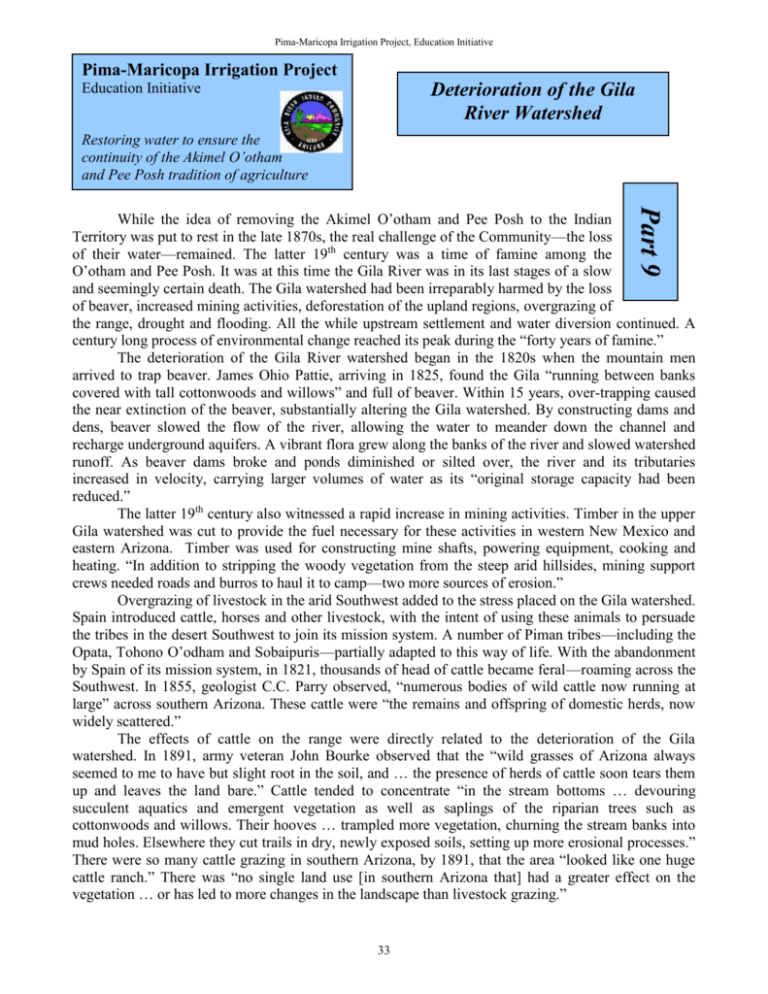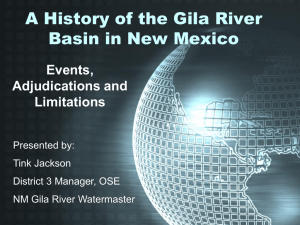Lesson 9
advertisement

Pima-Maricopa Irrigation Project, Education Initiative Pima-Maricopa Irrigation Project Deterioration of the Gila River Watershed Education Initiative Re water to ensure the Restoring continuity of the Akimel O’otham and Pee Posh tradition of agriculture Part 9 While the idea of removing the Akimel O’otham and Pee Posh to the Indian Territory was put to rest in the late 1870s, the real challenge of the Community—the loss of their water—remained. The latter 19th century was a time of famine among the O’otham and Pee Posh. It was at this time the Gila River was in its last stages of a slow and seemingly certain death. The Gila watershed had been irreparably harmed by the loss of beaver, increased mining activities, deforestation of the upland regions, overgrazing of the range, drought and flooding. All the while upstream settlement and water diversion continued. A century long process of environmental change reached its peak during the “forty years of famine.” The deterioration of the Gila River watershed began in the 1820s when the mountain men arrived to trap beaver. James Ohio Pattie, arriving in 1825, found the Gila “running between banks covered with tall cottonwoods and willows” and full of beaver. Within 15 years, over-trapping caused the near extinction of the beaver, substantially altering the Gila watershed. By constructing dams and dens, beaver slowed the flow of the river, allowing the water to meander down the channel and recharge underground aquifers. A vibrant flora grew along the banks of the river and slowed watershed runoff. As beaver dams broke and ponds diminished or silted over, the river and its tributaries increased in velocity, carrying larger volumes of water as its “original storage capacity had been reduced.” The latter 19th century also witnessed a rapid increase in mining activities. Timber in the upper Gila watershed was cut to provide the fuel necessary for these activities in western New Mexico and eastern Arizona. Timber was used for constructing mine shafts, powering equipment, cooking and heating. “In addition to stripping the woody vegetation from the steep arid hillsides, mining support crews needed roads and burros to haul it to camp—two more sources of erosion.” Overgrazing of livestock in the arid Southwest added to the stress placed on the Gila watershed. Spain introduced cattle, horses and other livestock, with the intent of using these animals to persuade the tribes in the desert Southwest to join its mission system. A number of Piman tribes—including the Opata, Tohono O’odham and Sobaipuris—partially adapted to this way of life. With the abandonment by Spain of its mission system, in 1821, thousands of head of cattle became feral—roaming across the Southwest. In 1855, geologist C.C. Parry observed, “numerous bodies of wild cattle now running at large” across southern Arizona. These cattle were “the remains and offspring of domestic herds, now widely scattered.” The effects of cattle on the range were directly related to the deterioration of the Gila watershed. In 1891, army veteran John Bourke observed that the “wild grasses of Arizona always seemed to me to have but slight root in the soil, and … the presence of herds of cattle soon tears them up and leaves the land bare.” Cattle tended to concentrate “in the stream bottoms … devouring succulent aquatics and emergent vegetation as well as saplings of the riparian trees such as cottonwoods and willows. Their hooves … trampled more vegetation, churning the stream banks into mud holes. Elsewhere they cut trails in dry, newly exposed soils, setting up more erosional processes.” There were so many cattle grazing in southern Arizona, by 1891, that the area “looked like one huge cattle ranch.” There was “no single land use [in southern Arizona that] had a greater effect on the vegetation … or has led to more changes in the landscape than livestock grazing.” 33 Pima-Maricopa Irrigation Project, Education Initiative When drought was added to the loss of beaver, deforestation and overgrazing, the deterioration was compounded. The Akimel O’otham and Pee Posh recognized that drought was a fact of life. “About every fifth year … the Gila River failed in midwinter, the flow diminishing day by day until at length the last drop of water … was licked up by the ever-thirsty sun.” The drought of 1890s devastated the southern Arizona range. Tens of thousands of cattle died but not before they consumed nearly all vegetable life. “Even the cactus, although girdled by its millions of spines, was broken down and eaten by cattle…. This destruction of desert herbage drove out or killed off many forms of animal life hitherto common” to the Sonoran Desert. The impact on the Gila watershed was dramatic: the “exploitation of the luxuriant grasslands,” which culminated in the deterioration of the range. The effects on the Akimel O’otham and Pee Posh were more dramatic, as these were the years of famine. The Pima Calendar Stick for 1898-99, for example, records “There was no crop this year.” While partially attributable to upstream diversions, destruction of the watershed caused widespread starvation in the Community, with at least five people perishing as a result. Flooding also impacted the landscape, particularly when cycled in among the other changes occurring in the watershed. Flash floods are normal in the desert and large-scale flooding occurs periodically. In a normal watershed, these variations are usually checked. In a watershed already under sustained attack the impact was multiplied, as exposed soils left the watershed open to large-scale erosion. Cycles of drought, followed by flooding, further devastated the Gila watershed. In the second half of the 19th century this devastation became more pronounced within the Community. Pima Calendar Sticks record floods that grew increasingly more severe. In 1833, the raging river flooded Akimel O’otham and Pee Posh lands with the river reported to be two miles wide. While the watershed had yet to be permanently altered, accelerated erosion had begun to occur by this time. Stephen Kearny observed that parts of the lower Gila, in the fall of 1846, already consisted of “sand, dust & black stone, so blistered from the effects of heat that they look like they had hardly got cool—no grass, nothing but weeds and cactus.” Characteristically, the year following the 1833 flood saw “bountiful crops” and the desert “carpeted with flowers and the bloom of cacti.” In 1868, another flood descended down the Gila Valley, perhaps the “most destructive ever known, destroying three of the Pima villages and a large amount of property on the lower Gila.” Having adapted to the desert over the centuries, the Akimel O’otham and Pee Posh understood the river and its periodic flooding. The destruction of their villages and the Casa Blanca trading post, located two miles from the river, might suggest that this flood was more powerful than any other they had previously experienced. The 1868 flood was just the beginning, as the Gila watershed could no longer slow and catch the waters and minimize erosion. Swifter flowing streams meant less recharge into the water table below. The latter 19th century witnessed the Akimel O’otham and Pee Posh searching for new village sites because of the decreasing river flow. New villages tended to arise in areas where water seepage was present. These were also the years of intense government pressure to induce the confederated tribes to accept removal from the Gila River Valley. While the west end of the Community enjoyed adequate water, periodic flooding washed out dams and irrigation headworks, making irrigation difficult to sustain. In 1891, yet another flood descended upon the Gila Valley. Above the reservation, the Gila River increased in size by 200 feet. Within the Community, O’otham lands were destroyed. The Pima Calendar Stick records “the channels of both the Gila and Salt rivers were changed in many places.” By the late 19th century, the Gila watershed had been so taxed that the river could no longer support the life it once had a century earlier. The river once occupied a “narrow channel as its bed was covered with large stones. There were no such stretches of bare and sandy waste…. Tall grasses, sometimes several feet high, covered the whole countryside yearly. But the once grassy swales are now 34 Pima-Maricopa Irrigation Project, Education Initiative for the most part saltbush steppe or desert. Lakes or ponds were once common over the river flats where there is no trace of them today.” Overgrazing, deforestation, the cutting of wood for fuel, droughts and flooding left the river open to prey. Loss of vegetation, deepening channels, more intense flooding and continued upstream diversions greatly impacted Akimel O’otham and Pee Posh lands. “The flood of 1891 was the death toll for the Gila, for the Pima way of life, and for much of the local flora and fauna…. Floods scoured much of the riparian growth, and drought weakened the rest. Riparian timber retreated from the unstable sandy meander of the river.” The Gila has yet to recover. Arizona’s Watersheds* * Courtesy of the University of Arizona Cooperative Extension 35 Pima-Maricopa Irrigation Project, Education Initiative Teacher Plan for “Deterioration of the Gila River Watershed” Terms to know and understand Watershed Deforestation Aquifer Tributaries Feral Arid Flora and fauna 1. Identify the causes of the deterioration of the Gila River watershed. 2. Explore and develop models for restoring the Gila River watershed. Objectives Student will be able to: What is a Watershed? The term watershed refers to a geographic area in which water and sediment drain to a common outlet, such as a stream, river, lake or ocean. For example, when it rains in the east end of the Gila River Indian Community (let’s say in District 2) the water may flow through a number of small washes, such as McClellan’s Wash, before it reaches the Gila River. The Gila River in turns flows into the Colorado River, which empties into the Gulf of California, which eventually ends up in the Pacific Ocean. Since all water within the Community eventually flows into the Gila River (even the Salt River empties into the Gila) the entire Community is part of the Gila River Watershed. Any small stream or river that flows into the Gila River is part of the Gila River Watershed. Some people refer to watersheds as drainage basins (think of the sink in which you wash your hands as the drainage basin or watershed. All the water coming out of the water faucet flows into this sink—or basin—and eventually leaves by way of the drain. The sink is the watershed while the drain is the river). No matter where you live you are in a watershed. Your watershed may be made up of farmland, cities, forestland, desert or other. Changes in the way this land is managed and used affect the quality and quantity of water in the watershed. As we observed in the reading selection, deforestation, overgrazing, drought and other factors harm watersheds and can cause changes that may be permanent. When the natural landscape of the land is altered, rain runoff is intensified. Without these natural protectors, greater amounts of water enter into streams and rivers. A higher and more rapid flow of water results, causing erosion and increased flooding. More water is also carried away, leaving less to recharge the underground aquifers. This means less water is available for use. Log onto the University of Arizona’s Cooperative Extension website @ http://ag.arizona.edu/waterquality/activityindex.html to access a number of activities related to watershed formation and deterioration. You may wish to log onto the US Environmental Protection Agency website @ www.epa.gov.com for additional information. About P-MIP The Pima-Maricopa Irrigation Project is authorized by the Gila River Indian Community to construct all irrigation systems for the Community. When fully completed, P-MIP will provide irrigation for 146,330 acres of farmland. P-MIP is dedicated to three long-range goals: Restoring water to the Akimel O’otham and Pee Posh. Putting Akimel O’otham and Pee Posh rights to the use of water to beneficial use. Demonstrating and exercising sound management to ensure continuity of the Community’s traditional economy of agriculture. 36






